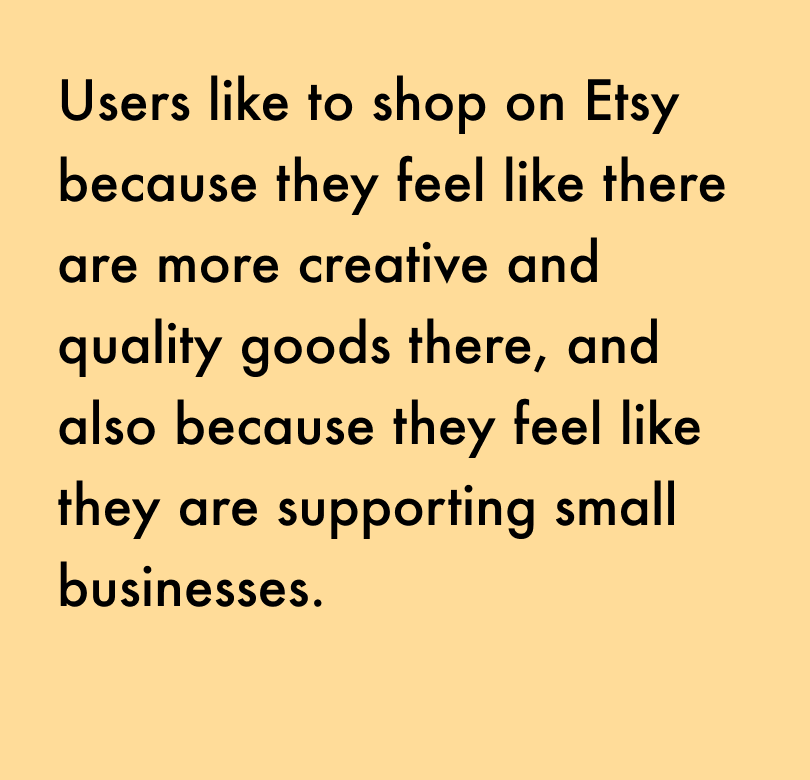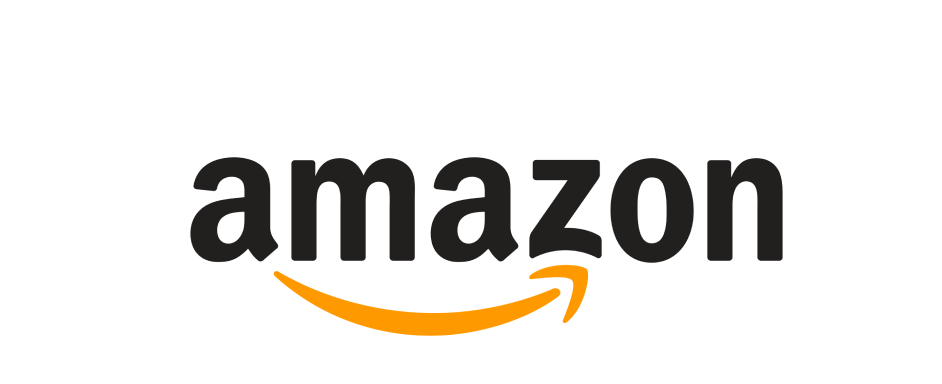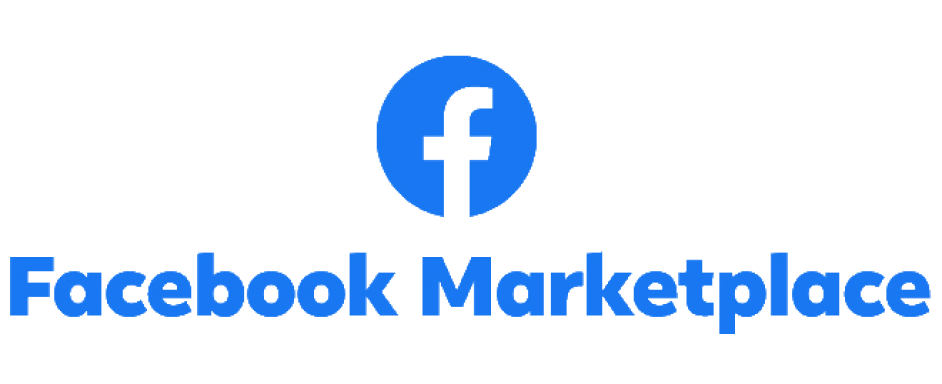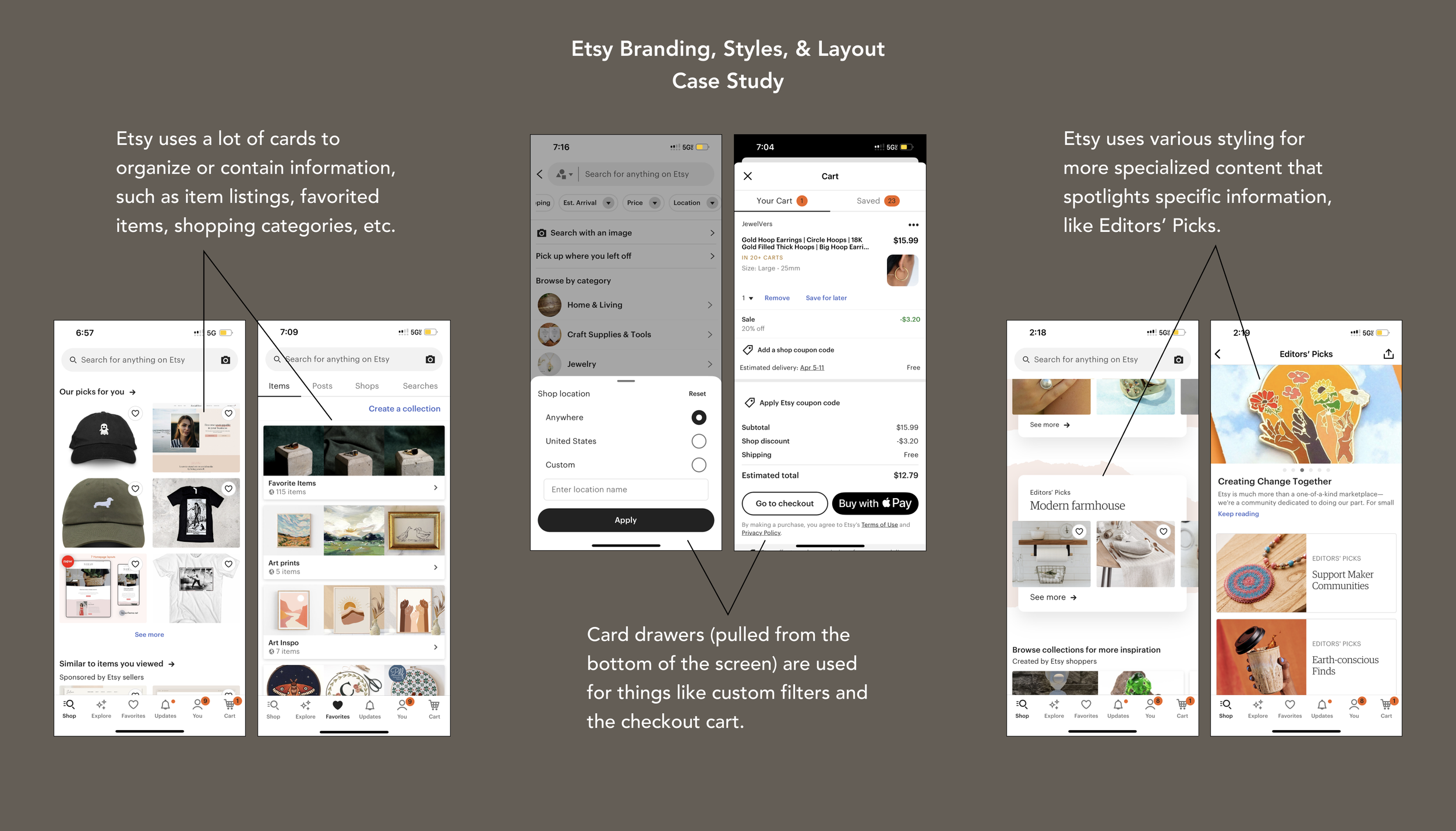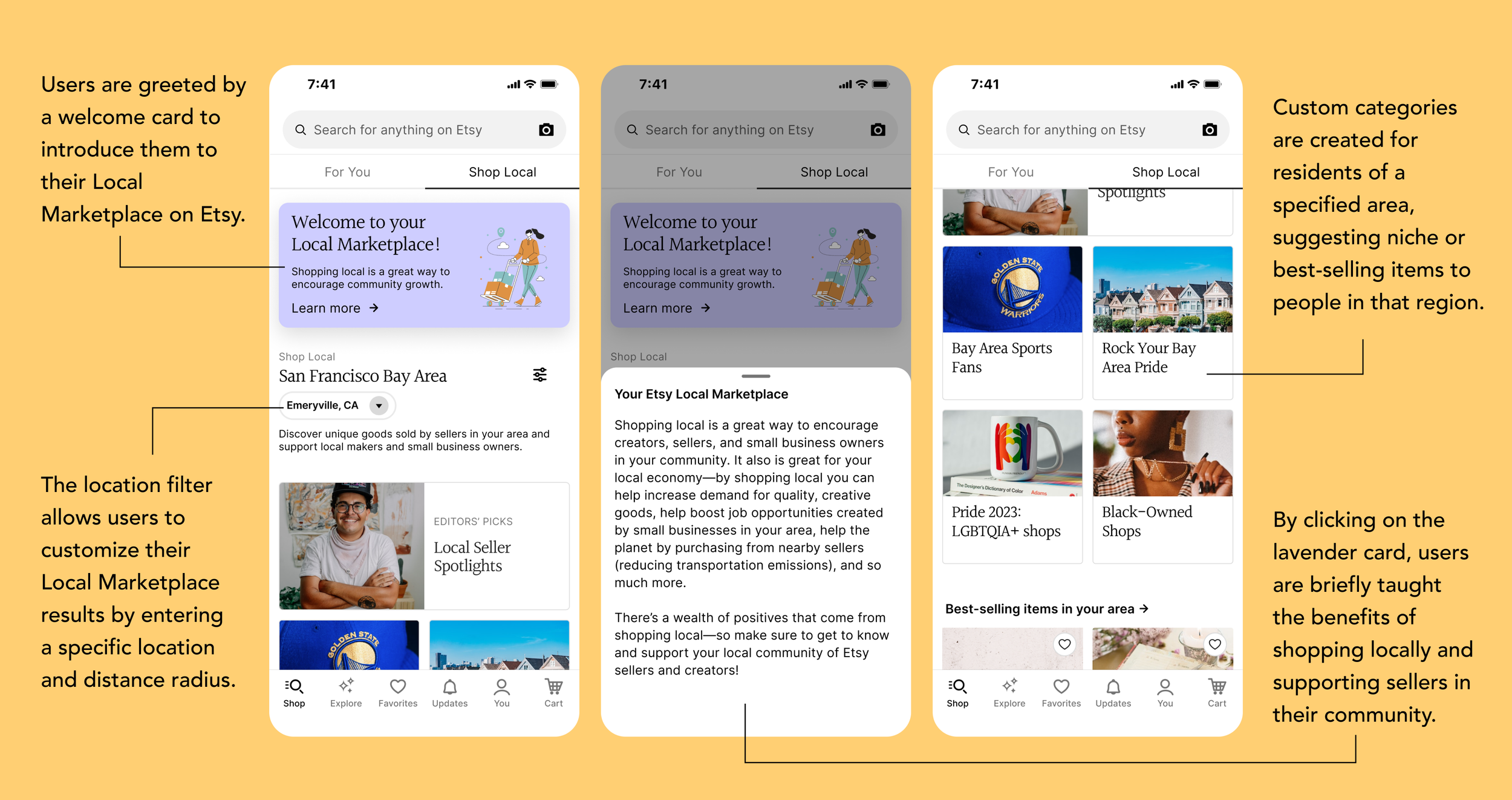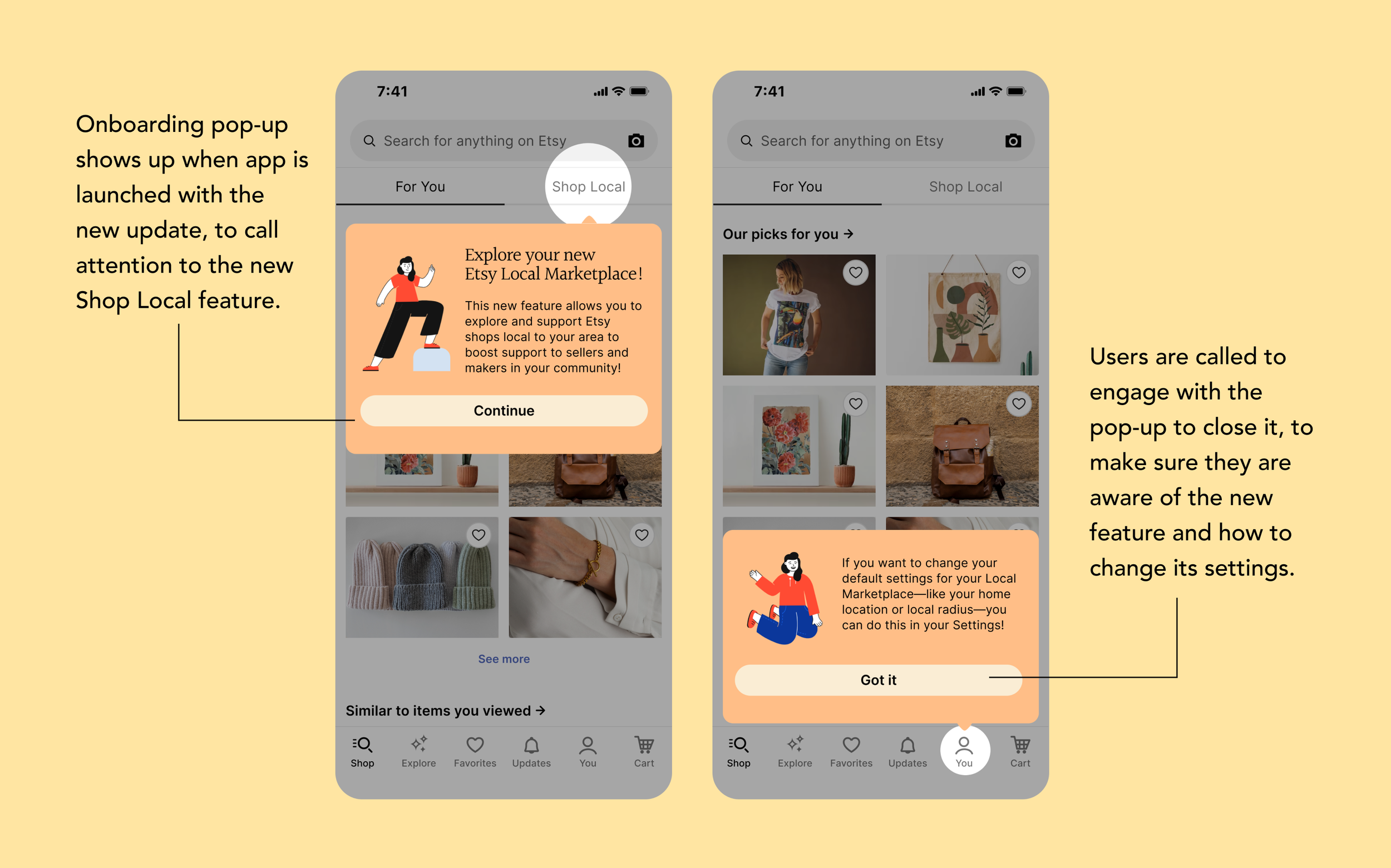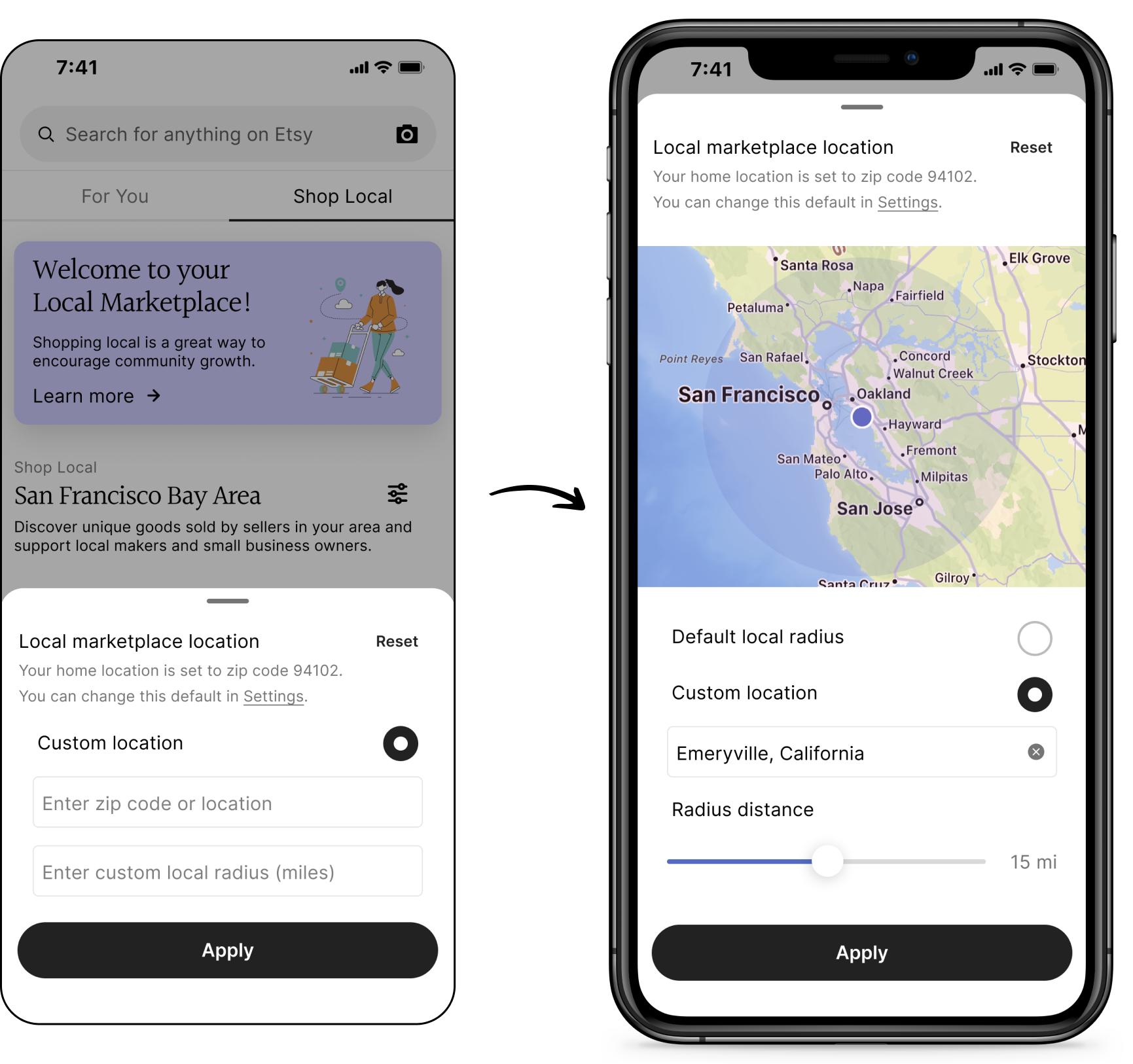
Etsy: Shop Local
Add a Feature to an App
Overview
Etsy is an online, global marketplace filled with individual sellers who offer unique and creative products, often hand-crafted and/or niche. This new shop local feature allows Etsy shoppers to better locate local sellers in their area so they can better identify, connect, and support the small businesses in their community.
Product
Part of Etsy’s mission is to “reimagine commerce in ways that build a more fulfilling and lasting world” and to “[build] a human, authentic and community-centric global and local marketplace.” When I began this project in early 2023, Etsy didn’t have an upfront way for customers to discover local sellers.
I thought this created several missed opportunities for the platform:
Because users aren’t made aware of which sellers are local to them, they are unable to intentionally connect with those small businesses and build a supportive economic community.
Consumers are more likely to make emotional purchases, particularly if they know their money is going to a good cause. If users knew which businesses were local, they might be more willing to follow through on purchases. They also might be less likely to spend their money elsewhere (on other sites).
Consumers like to buy products that speak to them, and local businesses are more likely to sell products that are reflective of an area’s culture and values—thus, connecting consumers to local businesses can drive up sales on the platform.
Problem
Role
UX Researcher, UX Designer, UI Designer
Tools
Figma, Maze, Google Forms, Calendly, Tactiq, Google Meet, Loom
Duration
6 Weeks
Research
As a frequent Etsy shopper myself, I always wished there was a way to identify local Etsy sellers because I wanted to intentionally browse and purchase from those local businesses. Diving into the research portion of this project, I sought to discover whether other Etsy users shared my sentiments. Do other Etsy users want to support local sellers? Would they find this new feature useful?
We want to know if consumers actually care about and find value in shopping locally. We also want to know why shopping locally is beneficial.
Research Goals
We need to understand what motivates users to shop locally.
We need to understand how users shop locally.
We need to understand why shopping locally is beneficial.
Research Objectives
User Surveys
Competitive Analysis
Secondary Research
Methods
I decided to distribute surveys to gather information from users. I surveyed users instead of one-on-one user interviews because I wanted the experience of creating and sending out surveys to collect research data. Additionally, this method allowed me reach more users in the time I was allotted for this project, thus providing me better insight into how users shop on Etsy.
User Surveys
RESEARCH
Survey Takeaways
USER MOTIVATIONS
I surveyed a total of 14 people:
There were 11 women and 3 men, ranging from 25–55 years old.
11 people said that they seek out places to shop where they can support small/local businesses.
There was a 50/50 split between mobile and desktop users for Etsy.
6 users had the Etsy app downloaded on their mobile device.
USER PAIN POINTS
I sought to learn what features already existed in the market, so I could determine the usefulness of a shop local feature on Etsy and/or find inspiration for what the new feature could look like. I analyzed three competitors that had at least one shared business function or objective as Etsy.
Competitive Analysis
RESEARCH
Analysis Takeaways
I looked at three competitors in the field:
Amazon, Facebook Marketplace, and Redbubble.
They are a large corporation with speedy shipping times and sell a great variety of products. They do have small businesses sell their items on their site with some recognition, but overall users have a sense that Amazon isn’t the best market to support small business owners, sellers, and creators.
This is a site that is most creatively aligned with Etsy, in that it’s a site where artists can sell products with their designs on them. While the site is vibrant and encourages the spirit of creativity and individuality, there isn’t a way for users to really connect with artists from their local communities. The artists still largely feel anonymous on this site.
They have a wonderful filter to narrow down sellers who are within a custom local radius to your location, so you can easily find items (usually second-hand) to purchase and pick up (or have the items shipped to you for a fee). Again, this isn’t really a market specific for small business owners and creators to sell their goods.
One of my research objectives was to find out if shopping locally is beneficial. I learned some first-hand reasons from users who took my research survey, but I also sought to dig deeper and read some articles (backed by stats) about the benefits of shopping locally.
Secondary Research
RESEARCH
Etsy’s mission is to “Keep Commerce Human,” and markets themselves as a global marketplace for unique and creative goods.
There’s a wealth of positives that come from shopping local:
Shopping local creates more jobs
Enhances diversity of products in the market
Strengthens local networks, creating an ecosystem of small businesses helping each other succeed
Boosts environmental sustainability
Local products can reduce environmental impact that national chains impose in their transportation of goods
Increase real estate values
More physical small businesses increases the value of a neighborhood, as it makes that neighborhood more desirable. New residences can also increase local tax revenue, which can be reinvested in local infrastructure
Better customer experience when shopping local
Majority of Americans desire to support local businesses
Small businesses are facing economic challenges and need support to stay afloat and flourish.
Takeaways
User Personas
Based on the research I gathered so far, I created user personas to represent the users I was designing this new shop local feature for. I created two personas to represent two sides of the coin: the Etsy shopper and the Etsy seller. It was important for me to consider both these types of Etsy users, so that I could tap into their goals, motivations, and frustrations as I attempted to problem-solve through my designs.
Ideate
Once I had my user personas created and organized the information I gathered from my research, I was ready to start brainstorming. By creating a point-of-view statement, this allowed me to define the goal I set out to achieve with this shop local feature.
I’d like to explore ways to help Etsy customers discover and connect with Etsy sellers that are in their local areas because they will feel more confident spending their money to support small businesses that are part of their local communities.
Defining the Goal
How might we connect Etsy customers to Etsy sellers in their local areas?
How might we help Etsy customers feel confident about making purchases on the site?
How might we transform shopping on Etsy into shopping at a local craft fair?
Questions to Consider
I came up with possible ideas for the feature based off of the three “how might we” questions I developed. I used two practical prompts—to keep myself grounded and to create more actionable ideas—and one “fanciful” prompt, to allow for creative exploration that could possibly spark innovation.
Brainstorming Ideas
IDEATE
Brainstorming Takeaways
Here were some of the top ideas that I pulled from my brainstorming session—these were the ideas that I found had the most potential, and which I ended up exploring further in the next step of the design process.
Prototype
Moving into the prototype phase of this project, I relied on the takeaways from my research and brainstorming sessions. But before I put pencil to paper and started drafting some initial wireframes, I knew I still had some work to do. This included familiarizing myself with the Etsy app and brand, determining which ideas for this feature I wanted to flesh out first, and focusing on how this Shop Local feature would be organized within the existing information architecture of the app.
I studied the existing Etsy app to familiarize myself with the navigation, styling, and brand before designing.
Studying the App
I prioritized what features to develop first, so I could figure out what to focus on now versus later.
Feature Roadmap
I visually mapped out where the feature would be located so I had a better grasp of its navigation.
Site Map
I created three task flows to better understand how users would interact with the new feature.
Task Flows
I sketched low-fi wireframes and digitized them in Figma, iterating on them to produce a high-fi prototype I could test with users.
Wireframes
I felt like it was really important to first familiarize myself with the Etsy app. What’s unique about this project was I wasn’t designing from scratch - I was designing for an app that had it’s own defined branding already.
Studying the App
PROTOTYPE
Feature Roadmap, Site Map, & Task Flows
Mapping it all out …
Feature Roadmap
Coming from the ideation phase of this project, I came out with a lot of ideas for this Shop Local feature. It was necessary for me to prioritize what features I wanted to focus on first, and what features could wait. This allowed me to better concentrate on developing the basic shape of the Shop Local feature—my goal was to make this feature practical and efficient, before diving into the more creative ideas I had in store for it. This way we could test how users would react to the base level Shop Local feature before making the feature more substantial.
Site Map
I needed figure out where to put the Shop Local feature so I started off by visually mapping out the current navigation of the Etsy app. Then I came up with two plausible places that I could add this new feature: within the Shop tab or by creating a brand new Shop Local tab on the navigation bar.
While both options made sense, I ended up choosing the first option and I placed the Shop Local feature within the existing Shop tab. I thought this was the better option because it would be less disruptive to the current app layout, and therefore would be less likely to confuse Etsy users when the new feature would be added.
Task Flows
With the site map created, I had a better understanding of how users would use and navigate the Shop Local feature. I developed three tasks, which I mapped out in task flows, that would further my understanding of how users would interact with the Shop Local feature.
With all the research and planning under my belt, it was finally time to draft the wireframes for this new Shop Local feature.
I started off as I usually do—by sketching out rough drafts of what the feature could look like in a notebook. I frequently referred to the Etsy app to make sure what I was drafting aligned with the current layout/structure of the app.
After sketching initial low-fidelity wireframes, I digitized and improved on them in Figma to create my mid-fidelity wireframes.
Working on Wireframes
PROTOTYPE
Low-Fi Wireframe Sketches
Mid-Fi Digitized Wireframes
High-Fidelity Wireframes
The Local Marketplace
The Local Marketplace is a hub that is custom to each user based on their home location. It is meant to promote local sellers’ shops and items so users are encouraged to support them with their purchases.
Part of the initiative to encourage users to shop locally was to also educate them on the benefits of doing so. I took some information I learned in my research and provided a card to briefly explain why shopping locally makes a difference.
Educating Users
One of the best things about the Local Marketplace is the way it provides customized item recommendations based on a shopper’s location. There are opportunities to suggest items that are culturally relevant to a region, like sports team gear, clothes repping a city’s name, etc. It makes shopping easier and more enjoyable for users!
Custom Content
While the users can set their default location in their settings for the Local Marketplace, they can also change their location using a filter. This might be helpful if users are temporarily in a different area, want to look up souvenirs from a particular region, or are shopping for gifts for loved ones who live elsewhere.
Location Filter
One of the best ways to encourage purchases is to make them emotional or meaningful. Seller spotlights provide users a chance to get to know their local Etsy shop owners more personally. By getting to know their story, users can put a face behind the name (or shop) and feel more confident in their local purchases.
Seller Spotlights
To further encourage users to shop locally, users are given special perks reserved for shops’ local customers only. This could include a local customer discount and free shipping.
Local Perks
I designed an onboarding tutorial for the launch of this new Shop Local feature to give users context on what the feature was, where it was located, and how to use it.
Since I placed the Local Marketplace within the existing Shop tab, I knew it could be easily overlooked by users. My goal was to call attention to the new feature, and force users to actively engage in the tutorial pop-up so that the feature could not be ignored.
Onboarding Tutorial
Testing & Iterations
Moving into the testing phase of this project, I sought to discover how users felt about the new Local Marketplace feature I designed. Is the feature straightforward to use? Is it a practical or useful addition to the app? Are there things I can make clearer or improve upon?
With this project, I saw the opportunity to explore a new testing method—using Maze as the usability testing platform—to gather data from Etsy users. From the testing results I moved on to make iterations on my designs to improve user experience.
I wanted to see if users could easily understand how to navigate to and use the new Local Marketplace feature.
I wanted to see if users found the new feature useful and desirable.
Testing Objectives
Maze
Testing Method
I found users to test my designs that met these two requirements:
They have shopped and made a purchase on Etsy before.
They like to shop locally and support local, small businesses.
Testing Users
Maze is a hands-off way to conduct usability testing, which I thought was the perfect tool to explore using for this project. By using Maze, I not only was able to get a lot more users to test my designs, but I also got access to Maze’s insightful data reports. I received interesting testing data that included heat maps, number of misclicks, success metrics, and more.
I had 12 total testers. 100% of the users identified as female, ages 22–36 years old. All users said they resided in the United States, and that they had shopped on Etsy before. The majority of the testers said they shopped locally at least a few times a year.
Testing with Maze
TESTING
I wanted to see if users could easily understand how to navigate to and use the new Local Marketplace feature.
I wanted to see if users found the new feature useful and desirable.
Testing Objectives
Maze
Testing Method
I found users to test my designs that met these two requirements:
They have shopped and made a purchase on Etsy before.
They like to shop locally and support local, small businesses.
Testing Users
Achievements (Hi-Fi Wireframes)
Local radius filter:
I changed the look of the filter and the placement of the filter on the Local Marketplace home page, so that it looks more obvious that it is an Etsy filter (I also changed it so it visually looks like Etsy’s other existing filters).
I also changed how the filter worked, and modeled it off of Facebook Market’s local radius filter, so that users can visualize the radius by seeing a map and customize it with a slider instead of just using a text input.
Shop Local “Learn More” Card:
I made this card more visually appealing by breaking up the text with bullet points, bolding some words, and adding in some illustrations. While I did make these changes, the only worry I have is that it looks a little different from what I’m used to seeing on Etsy.
Local item pick-up:
I received a lot of comments from users expressing their wish for the ability to pick up items instead of getting them shipped. Some noted it would be great to save on shipping - and while I marked the shipping as “free” on the prototype, I realized that this wasn’t completely clear that local customers would receive free or reduced shipping costs.
I did have the idea of adding a pick-up option when I initially was brainstorming for this project, but I wondered if this would be too complex to set up. But since I received so many comments from testing about this, I thought I could at least come up with the option of incorporating this item pick-up idea.
I came up with the idea that perhaps certain sellers can opt in to do this local item pick up, since I know not all Etsy sellers would want to provide this anyway. I also considered that Etsy sellers probably would not like to reveal their home address to strangers (plus there would be a safety issue if this pick up was not organized at a public space).
So, my thinking was that some sellers could verify that they will appear at a public space somewhere, at an established set time. For example, if a seller knows that they always set up a booth at a Farmer’s market on Sundays, or if they have a physical shop location somewhere.
I designed a free local pick-up card, where users can notice that that option is available to select at check out. My thought is, once they checkout, the confirmation will let users know that their item is available for pick up on a certain date, with a time range. Users can also message the seller to change to a different date if allowed.
ITERATIONS
Location Filter
ITERATIONS
Local Marketplace “Learn More” Card
I had some users comment about the location filter—there was about an equal amount of users who said they thought it was easy to recognize and intuitive to use, versus the amount of users who commented that they were expecting something different.
A few users pointed out that the “Learn More” card text was too much text to read, so I edited the section to make it easier for users to quickly read. I bolded key words, broke up the information into sections, and added illustrations to provide more visual interest and context.
I ended up tweaking the filter a bit to make it more user friendly:
I changed the placement and look of the location filter on the Local Marketplace home page. By changing the look of the filter, it made it stand out more on the app so users can more easily spot and use the filter. I also made the filter look more in line with already existing filters on the Etsy app.
I also changed how the filter worked, and modeled it off of Facebook Market’s local radius filter, so that users can visualize the radius by seeing a map and customize it with a slider instead of just using text input.
ITERATIONS
Location Filter
Many of the users noted that they would love to have the option to pick up an item purchased from a local seller, since it would be more convenient, allow them to save on shipping costs, and/or would reduce shipping waste.
When I was brainstorming for this project, I did have the idea to incorporate a local pick-up option, but I didn’t move forward with it because I thought it would be too complex to set up. But because many of my testers really pushed for this feature, I decided to incorporate local pick-up in my final designs.
For the local pick-up feature, local sellers who would like to participate would go through a verification process to set up where their local Etsy customers could pick up items in a public space. This could be at a weekly farmers market, a storefront (if they have one), etc.
Users can learn more about a seller’s pick-up details through a green card that shows on the seller’s storefront or item listing. Users can then opt for the pick-up option when they checkout.

